Temple Israel
In 1954, 40 young families met to create a new Conservative congregation that would fill their spiritual, cultural and educational needs. Calling their congregation Temple Israel, they adopted a charter, hired Rabbi Philip Shnairson, purchased a former downtown church and began operation a year later.
The congregation’s leadership has truly fulfilled “generation to generation.” Louis Feinberg, Dick Katz, Daniel Wise and Lori Pearson Wise followed the lead of family members Frank Stein, Lou Katz and Abe Wise as presidents. Many other members have been leaders of the Jewish Federation and the Roth Family JCC.
Outgrowing the building, a larger one was constructed on Eli Street. As the Jewish population shifted north, Temple Israel relocated twice, finally to Winter Springs where it is today. Sixty-three years later, many founding families and their children are among the 200 members. Temple Israel remains a vibrant and active congregation.

Temple Israel Houses of Worship, 1954–Present.
On August 3, 1954, the new congregation purchased the Central Christian Church building at the corner of Cathcart Avenue and Ridgewood Street (top photo). Nine years later, as the congregation grew, they built a larger facility at 4917 Eli Street in Orlando (photo middle left). The third facility located at 500 Markham Woods Road in Longwood (photo middle right) was completed in 2003 and then sold. In 2007, the congregation purchased a former Seventh Day Adventist Church, (bottom photo) at 50 S. Moss Road in Winter Springs, which is their current home.
Temple Israel Archives
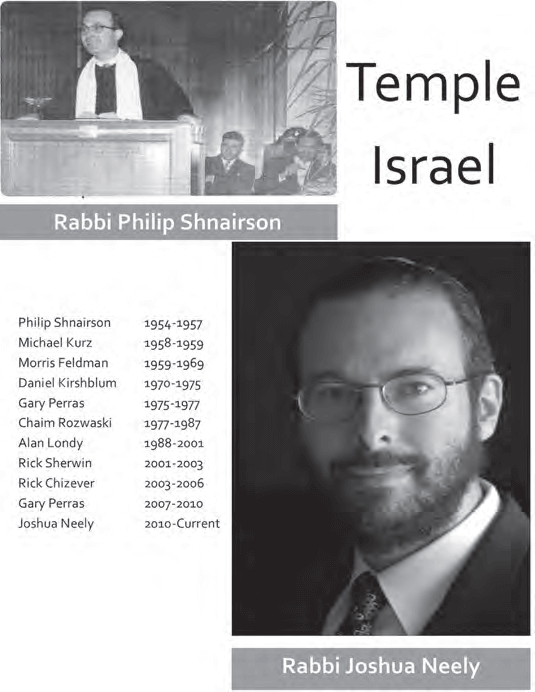
Rabbinic Leadership, 1954–Present.
In the Jewish community, a rabbi is viewed as a spiritual leader and as a counselor, role model and an educator. A congregational rabbi leads spiritual services and officiates at life cycle events such as bar mitzvah, bat mitzvah, baby naming ceremonies, weddings and funerals. Rabbi Philip Shnairson was Temple Israel’s first rabbi. The current rabbi is Rabbi Joshua Neely who was hired in 2010 and continues in the position.
Temple Israel Archives
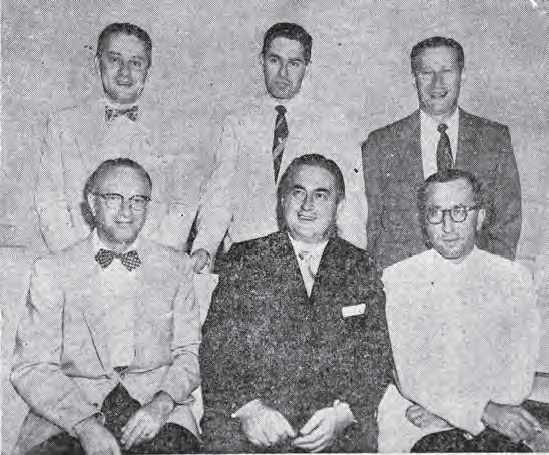
First elected officers, 1954.
The first year was focused on establishing a viable, vibrant, energetic congregation. This was accomplished by many volunteers teaching in the religious school, participating in the choir for Shabbat (Jewish Sabbath; Friday night to Saturday night at the appearance of the first stars) and holiday services, cooking and support for simchas and other social activities. Of these first officers, Jerry Bornstein and Lou Katz later became presidents of Temple Israel.
Front row L-R: second vice president Al Emoff, president Frank Stein, first vice president Jerry Bornstein; back row L-R: secretary Seymour Lustig, corresponding secretary Oscar Tetenbaum and treasurer Louis Katz
Collections of the Jewish Museum of Florida-FIU, originated by Marcia
Jo Zerivitz, LHD, Founding Executive Director
Land for the Temple Israel Cemetery was purchased in 1954 by brothers Abe and Zelig Wise shortly after Temple Israel began operation in 1954, 2016.
With the original tract of 10 acres in a tranquil lakefront setting, plus the purchase of an additional acre, the cemetery has enough burial space to last many more decades. The Jacob “Yank” Frank Memorial Chapel is located on the grounds which also include a mausoleum park and designated areas for cremated remains and interfaith burials. All burial services and rituals are provided under strict rabbinical consultation and supervision.
Temple Israel Cemetery Corporation

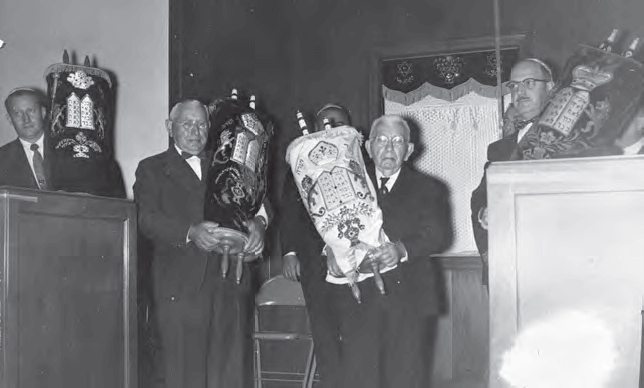
Dedication of the Torahs for prayer services, 1954.
The Temple Israel congregation celebrated the placing of Torahs in the ark of its newlypurchased facility. The Bornstein brothers donated two of the sifrei Torahs.
L-R: Louis Katz, Abraham M. Bornstein, Barnett B. Bornstein and Ben Glaser
Collections of the Jewish Museum of Florida-FIU, originated by Marcia Jo Zerivitz, LHD, Founding Executive Director
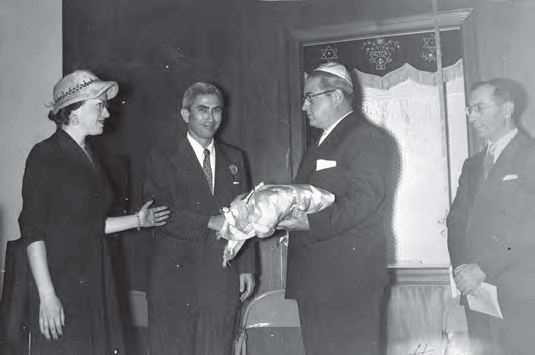
Ruth Esther and Joseph Wittenstein (left) present parochet to President Frank Stein (center) at the 1954 Temple Israel dedication ceremony.
On the right is Dr. Sanders Tofield, Rabbi of Jacksonville Jewish Center, representing the Conservative movement whose mission is to conserve Jewish tradition.
Collections of the Jewish Museum of Florida-FIU, originated by Marcia Jo Zerivitz, LHD, Founding Executive Director
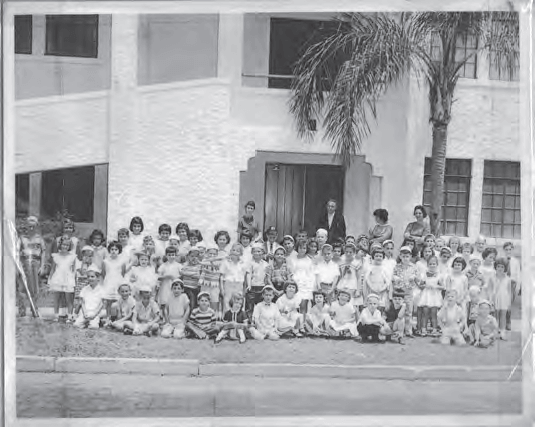
Four grades in the Temple Israel religious school were in full swing by October 1955.
Regular Sunday and weekday sessions were under the direction of Dr. Meyer S. Cohen, who headed the congregation’s education department. The Sunday school included a full program of Bible studies, holidays, customs, ceremonies, music, arts and crafts and drama. The weekday classes offered a complete course of Hebrew including reading, writing, translation and spoken Hebrew.
Temple Israel Archives
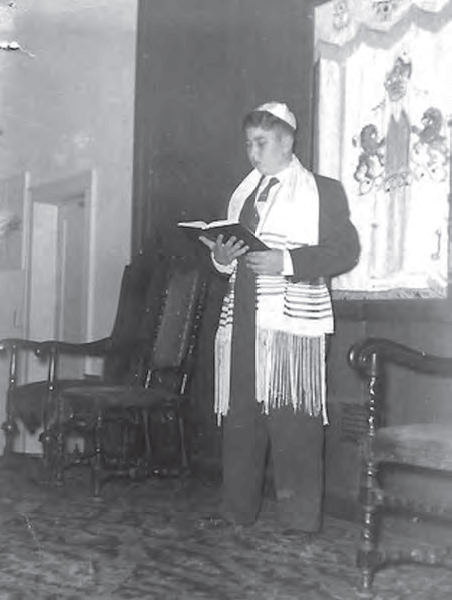
Laurence Morrell was Temple Israel’s third bar mitzvah, October 1955.
Morrell, son of founders Albert & Dorothy Morrell, continues to be active at Temple Israel. He has served as a Shabbat school teacher, advisor to the USY (the youth group), board member and officer. Morrell celebrated the 60th anniversary of his bar mitzvah at Temple Israel’s South Moss Road synagogue during Shabbat services in 2015.
Laurence Morrell
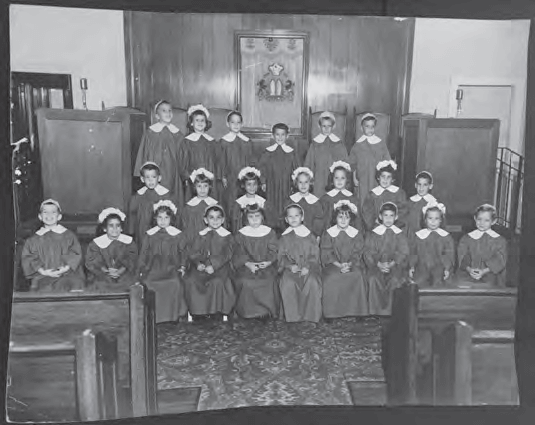
Consecration, 1964.
The ceremony is usually held in conjunction with Simchat Torah. Each child is presented with his/her own siddur that has been decorated by a family member.
Temple Israel Archives
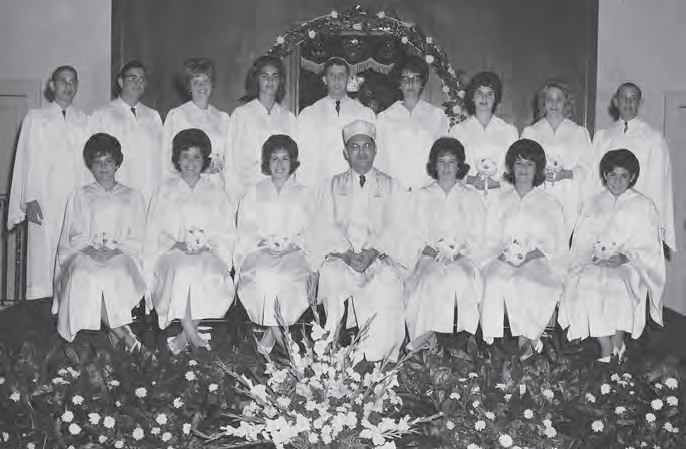
Confirmation, 1963.
Following bar and bat mitzvah, continuing studies help develop a more personal understanding of and commitment to Judaism. Students learn how their traditions and history relates to daily life and the issues that face them in contemporary society.
First row L-R: Patsy Lazar, Ilene Reiss, Beverly Cooper, Rabbi Morris Feldman, Debbie Gluckman, Donna Arost, Susan Geller; second row L-R: Harvey Levitt, Barry Goldfarb, Robin Sulman, Ruth Falk, Gary Shader, Sandra Van, Rosalind Gould, Marilyn Klopman, Larry Kamenoff
Harvey Levitt
Groundbreaking ceremony for Eli Street synagogue, 1963.
The Wise family donated a plot of land for the construction of Temple Israel’s second building. The project was a twophase construction plan. Its faceted glass windows, designed by Tess Wise, became a focal point of the sanctuary. When completed, there would be a sanctuary with seating for 350, a large social hall, kitchen, classrooms and administrative offices. L-R: Abe Wise, Rabbi Morris Feldman and Sidney Brown
Temple Israel Archives
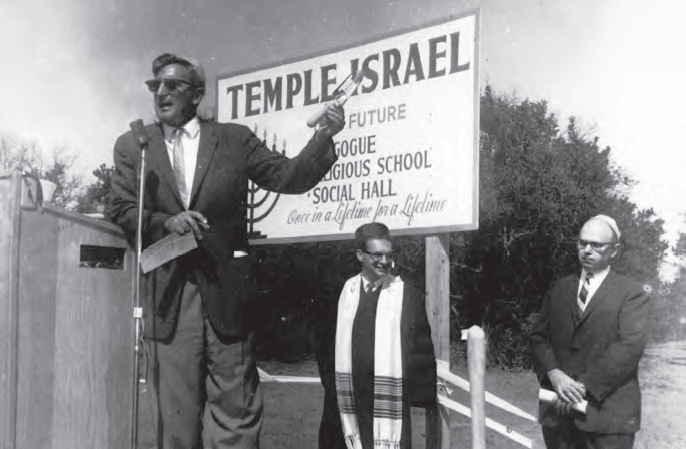
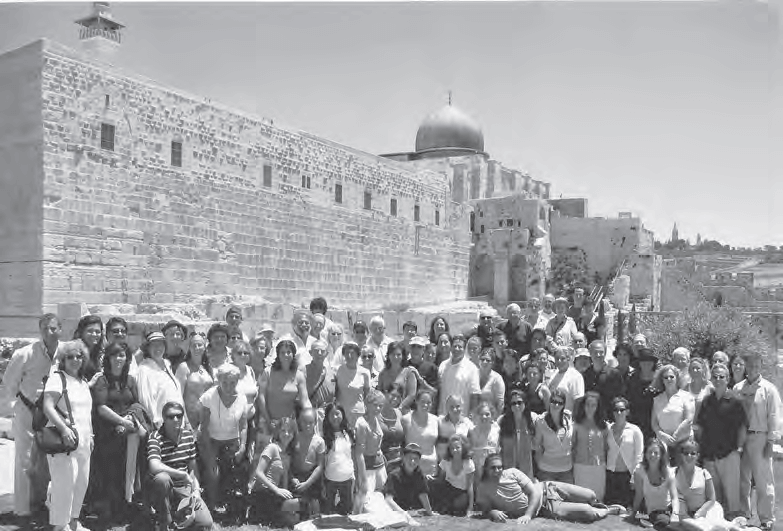
A congregation trip to Israel is a learning and bonding experience between participants and the spiritual home of the Jewish people, Jerusalem, 2006.
Several adults and children in the group became B’nai Mitzvah at the south section of the Western Wall shown here together with the Southern Wall of the Temple Mount at the entrance to the Jerusalem Archaeological Park. Adjacent is the Davidson Center, one of the largest, most significant archaeological sites in the country where one can explore the city of 2,000 years ago on the eve of its destruction by the Romans in the year 70.
Temple Israel Archives
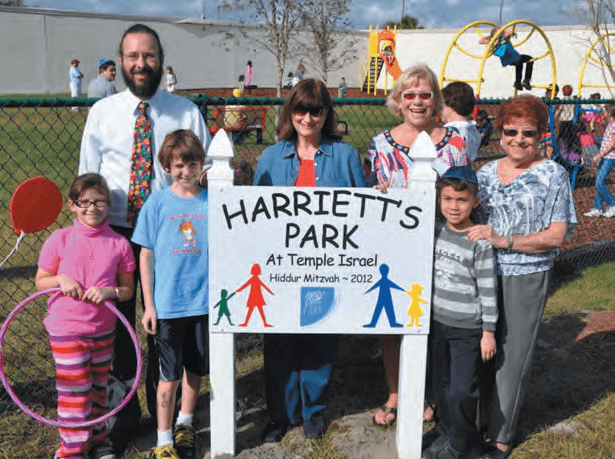
Harriett’s Park, a new playground named in honor of Harriett Lake and officially dedicated at Temple Israel on December 16, 2012.
A group of congregants enjoyed choosing swings, slides, and state-of-the-art equipment and benches. The park joined Harriett Lake’s other most recent project at Temple Israel—Harriett’s Kitchen—in making Temple Israel an even better place for praying, learning, mingling and playing. The playground has state-of-the-art equipment and benches. A dedicated group of congregants had more fun choosing swings and slides than any other project undertaken in a long time. Back row L-R: Rabbi Joshua Neely, President Arlene van de Rijn, Chairperson Jo Ann Farb and Phyllis Kamenoff
Temple Israel Archives
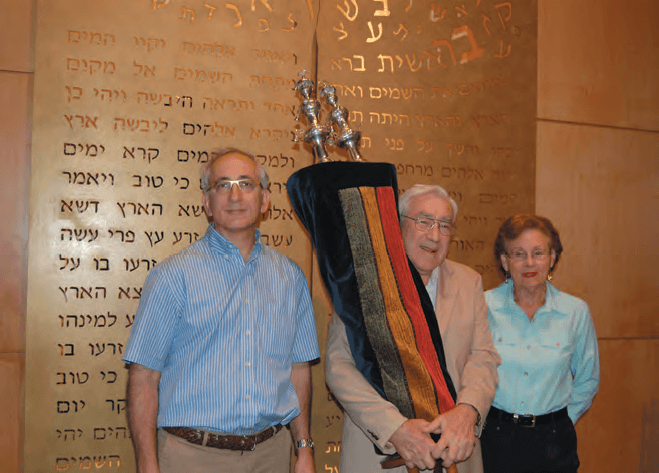
L-R: Daniel Wise, Harry Rein and Rhea Rein were part of a delegation from Temple Israel that accompanied the congregation’s Goold Torah to Berkach, Germany, for the 160th anniversary of the 1854 opening of the Berkacher Synagogue, June 1, 2014.
This Torah was written by Hirsch Hessberg especially for the Berkacher Synagogue’s opening. His descendant Lothar Hessburg Goold saved the Torah from destruction when he fled the Nazis and brought it to Temple Israel. In 2014, the scroll was welcomed back to where it had been used until Hitler forced the Berkacher congregants to flee or face deportation and murder. The sponsors of the 160th Jubilee in Berkach asked Temple Israel to lend the historical Torah as part of the commemoration.
Temple Israel Archives
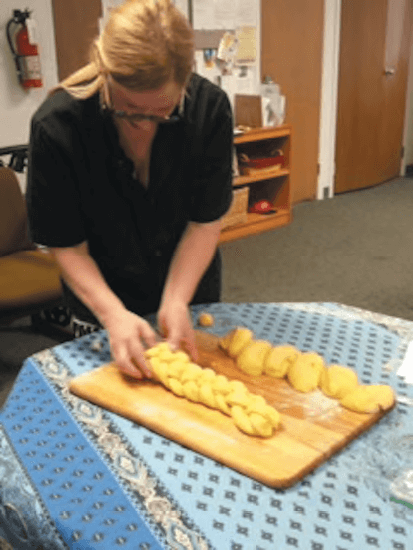
Debra Markowitz, Temple Israel congregant and extraordinary baker, braiding challah (bread) at a Share the Care adult day-care site, 2016.
Share the Care is a non-profit organization specializing in adult day care and respite care for frail, physically and cognitively impaired adults. As she mixed the ingredients and kneaded the dough, Debra told the day care clients about the part challah plays in Jewish life, including the most sacred ingredient: love. A Jewish daycare client helped her knead the dough, showing she made challah long ago. The best part of the demonstration? Eating the finished product.
Temple Israel Archives
